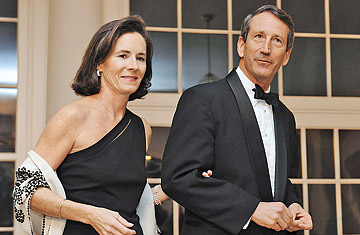
South Carolina Governor Mark Sanford arrives with his wife Jenny at a White House dinner held by President Obama for the National Governors Association on Feb. 22, 2009
(2 of 7)
In the e-mails exchanged between the governor and his girlfriend, they trip over themselves to praise the other's virtues. She was "special and unique," "glorious"; he was a man of emotional generosity who "brought happiness and love to my life." These two humanitarians were engaged not only in worshipping each other's high-mindedness but also in destroying another woman's home, hobbling her children emotionally and setting her up for humiliation of a titanic proportion. The squalor and pain that resulted from the Sanford and Ensign midlife crises make manifest a bleak truth that the late writer Leonard Michaels once observed in his journal: "Adultery is not about sex or romance. Ultimately, it is about how little we mean to one another."
And so two more American families discover a truth as old as marriage: a lasting covenant between a man and a woman can be a vehicle for the nurture and protection of each other, the one reliable shelter in an uncaring world--or it can be a matchless tool for the infliction of suffering on the people you supposedly love above all others, most of all on your children.
In the past 40 years, the face of the American family has changed profoundly. As sociologist Andrew J. Cherlin observes in a landmark new book called The Marriage-Go-Round: The State of Marriage and the Family in America Today, what is significant about contemporary American families, compared with those of other nations, is their combination of "frequent marriage, frequent divorce" and the high number of "short-term co-habiting relationships." Taken together, these forces "create a great turbulence in American family life, a family flux, a coming and going of partners on a scale seen nowhere else. There are more partners in the personal lives of Americans than in the lives of people of any other Western country."
An increasingly fragile construct depending less and less on notions of sacrifice and obligation than on the ephemera of romance and happiness as defined by and for its adult principals, the intact, two-parent family remains our cultural ideal, but it exists under constant assault. It is buffeted by affairs and ennui, subject to the eternal American hope for greater happiness, for changing the hand you dealt yourself. Getting married for life, having children and raising them with your partner--this is still the way most Americans are conducting adult life, but the numbers who are moving in a different direction continue to rise. Most notably, the Centers for Disease Control and Prevention reported in May that births to unmarried women have reached an astonishing 39.7%.
How much does this matter? More than words can say. There is no other single force causing as much measurable hardship and human misery in this country as the collapse of marriage. It hurts children, it reduces mothers' financial security, and it has landed with particular devastation on those who can bear it least: the nation's underclass.
The Marriage Gap
The poor and the middle class are very different in the ways they have forsaken marriage. The poor are doing it by uncoupling parenthood from marriage, and the financially secure are doing it by blasting apart their unions if the principals aren't having fun anymore.
